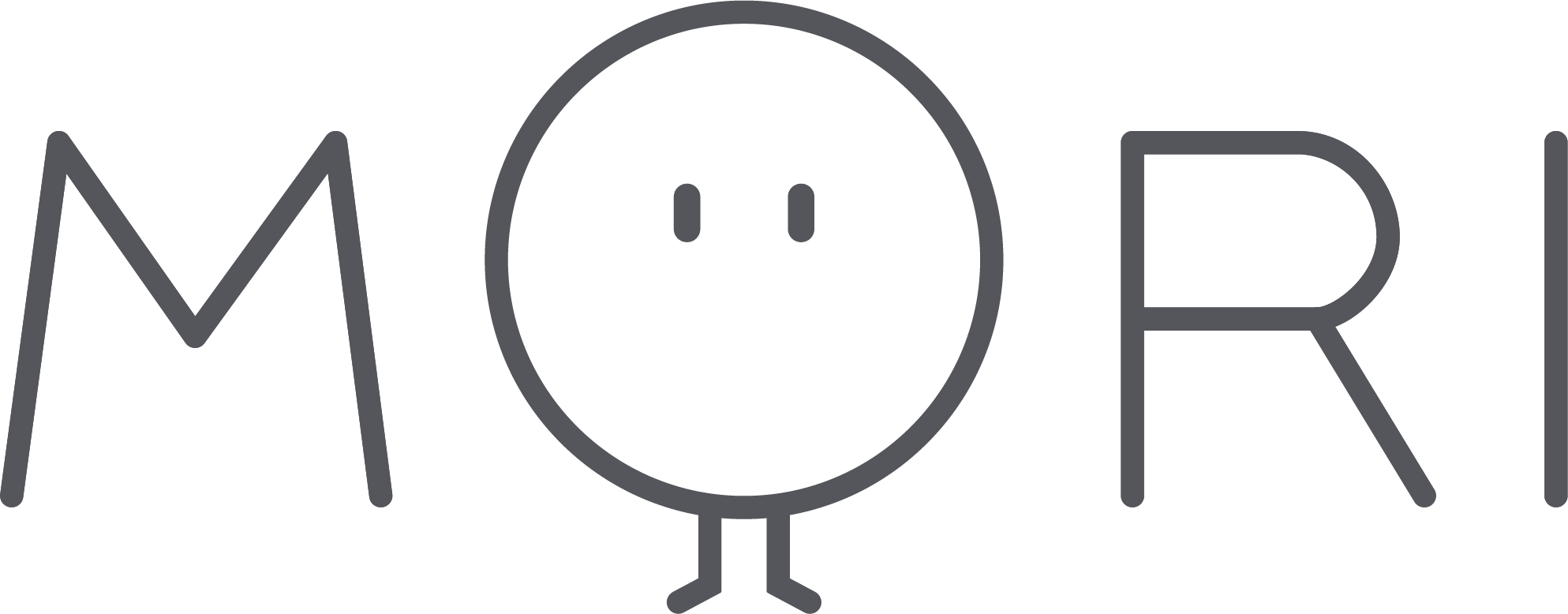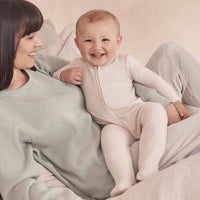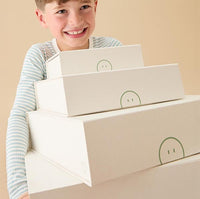Our ultimate feeding guide

Feeding your new baby can feel tricky and overwhelming, and navigating it can bring up a lot of emotions. Every motherhood journey is different and there’s no one size fits all way to feed your baby, just the way that works for you both & makes you happy.
We want mothers to feel supported and empowered as they raise their little ones so we’ve teamed up with My Expert Midwife to share some amazing breastfeeding tips and how to prepare.
We've also brought together three brands - Kendamil, Elvie & Tommee Tippee - who cover all other areas of feeding and asked them to share digestible information, advice and tips so you feel confident doing what works for you.
How to prepare for breastfeeding with My Expert Midwife

Featuring the Mama Jumpsuit
Tip 1: Ask for help sooner rather than later
One of the most common problems which can have knock on effects for both you & baby is incorrect latch and attachment at the breast. Having expert help on hand to assist with any issues can mean the difference between breastfeeding continuing or not. Ask for help sooner rather than later from your midwife, midwifery support worker, lactation consultant or health visitor.
Tip 2: Use a nipple balm
If you develop cracked, sore or bleeding nipples you can continue to feed your baby whilst receiving help with latch and attachment. As your nipples can become sore & painful whilst they recover, you can use a nipple balm to help soothe & protect them. Choose one which is smooth to apply and doesn’t need to be removed before feeding.
Tip 3: Up to 10% of babies may have some form of tongue-tie
This can affect latch and attachment. Tongue-tie involves the frenulum, which anchors the baby’s tongue to the bottom of the mouth, it can extend towards the tip of the tongue more than normal or is thicker, thus restricting movement. You, a midwife or another health professional can identify a tongue-tie, but it is important to remember that not all babies who have a tongue-tie will have feeding difficulties.
Tip 4: Feeding will help to relieve the uncomfortable feeling of fullness
Engorged breasts happen when you have an overproduction of breastmilk, it feels like your breasts are full & solid and can sometimes mean your baby struggles to latch on. It is most common and quite normal to experience this during the first week or so after the birth as the ‘milk comes in’ and can be quite uncomfortable for a day or two. You can hand express some milk off to relieve any pressure (try this during a warm bath or shower) but try not to express too much as this can overstimulate the breast to make more milk.
Tip 5: Blocked milk ducts and mastitis can be linked
Mastitis is a condition where one or both your breasts become swollen, red, hot & often painful to touch. It is an inflammatory response to milk in the breast tissues. Feeding from the affected breast is what will help to resolve the mastitis as this drains the milk from the breast. Make sure your breasts are not restricted by tight clothing or a bra which doesn’t fit properly, as this could be causing the problems. Trying a gentle breast massage or placing chilled cabbage leaves inside your bra can provide some temporary relief. If symptoms persist contact your midwife or GP.
Tip 6: Thrush can develop whilst breastfeeding in both your breast & your baby’s mouth
You will be able to see thrush in your baby’s mouth as a white coloured film which can’t be removed with gentle wiping. Your symptoms are usually characterised by pain in both breasts which doesn’t resolve itself. If you or your baby have been given antibiotics during or after the birth, you or your baby are more likely to develop thrush. Both you & baby need treatment for thrush, usually in the form of cream and a gel, otherwise it can be passed back & forth. Your GP can prescribe treatment for this.
To help with milk spills during feeding, our double-ply bibs have an extra internal layer to maximise absorption. Our soft and versatile organic baby muslins are made in a range of sizes to suit your needs. Whether you’re using them for swaddling, snuggling or breastfeeding, they’re ideal for having around the home, in their nursery or using when out & about.
How to master pumping with Elvie

Featuring the Bump to Baby Pajamas
Biggest tip: focus on the positives
When you’re pumping, try and remember why you’re doing it. One of the biggest positives of using a breast pump is it will allow your partner to do some of the night feeds which helps them bond with the baby, as well as helping you get some of your independence back. You can leave your little one with your partner while you go out for lunch with friends and don’t need to worry about them going hungry. So make getting to grips with your breast pump a priority.
Tip 1: Give yourself adequate time so that you’re not rushing or stressed out
In the beginning, pumping might take about 40 minutes. But once you’re used to it, pumping with an electric pump will usually only take 15-20 minutes.
Tip 2: Pumping shouldn’t hurt
If it does, try changing the size and/or position of the breast shield. Don’t just put up with it mama.
Tip 3: The more you pump, the more milk you produce
So aim to pump at least every 3-4 hours to keep up or increase your milk supply.
Tip 4: Try to relax when you start the pumping process
Put something on the TV that requires no concentration and just concentrate on the task at hand (or boob).
Tip 5: Give yourself a little self-massage
Mums tend to express more milk when they massage the breast as they pump.
Tip 6: Staying hydrated is essential
Drink plenty of water and try to avoid too much caffeine. As with all health advice, avoid smoking. Smoking can reduce your milk supply, alter the taste and interfere with your baby’s sleep.
Tip 7: Don’t be afraid to ask for help when you need it
Reach out to breastfeeding support in your area or ask your midwife or health visitor. Take care of yourself and never suffer in silence.
To make sure you’re as comfortable as possible, wear loose and soft clothing which has a natural stretch. Our mama by MORI collection is innovatively designed with you in mind to be comfortable and supported. The collection is crafted in softer-than-soft sustainable lyocell with natural stretch to adapt to your changing body. For new mama's, the Bump To Baby Nightdress has button fastenings on the front meaning it's perfect for fuss-free feeding or pumping.
Top tips on feeding with Tommee Tippee

Working together as a breastfeeding team
Bringing up a baby takes a village, and although there’s only one pair of boobs, there are lots of ways that others can chip in and help.
Tip 1: Do your research before the baby arrives
Make sure you talk to mum about her preferences and plans. Make sure she knows you know your stuff and you support any feeding decision she makes.
Tip 2: Offer encouragement
Be her breastfeeding cheerleader and offer verbal encouragement and support throughout.
Tip 3: Keep her company
Ask her if she’d prefer alone time with the baby or if she’d like you to stick around and chat.
Tip 4: Stand up for her right to breastfeed
Become a breastfeeding advocate and support every mum's right to breastfeed in public without criticism.
Breastfeeding & returning to work
Breastfeeding is a lovely way to maintain the close bond you’ve built over maternity leave, and you don’t need to stop just because you’re going back to work!
Tip 1: Practice with a bottle before you go
Let your baby practice taking expressed milk from a bottle before you go back to work, that way they’ll be used to it when the time comes for them to take a bottle.
Tip 2: Prep your milk
Breastfeed when you’re at home and express milk using a pump so that someone can feed them while you’re away.
Tip 3: Communicate with your employer
Talk to your employer early on about your choice to continue breastfeeding when you return to work and ask if they have a breastfeeding policy to support you.
Bonding with baby while breastfeeding
Bonding with your new baby is one of the most special moments you’ll experience as a parent, and no matter how you choose to feed, mealtime is a great opportunity to build that bond.
Tip 1: Keep eye contact
As well as increasing the bond between the two of you, it can also improve their non-verbal communication and boost their social skills.
Tip 2: Skin to skin contact
It releases oxytocin (the love hormone) which warms up the feeder's body and makes your baby comfortable and relaxed.
Tip 3: Talking and singing
Talking and signing to your little one while bottle feeding creates a really powerful emotional bond with them, even from a really young age.
Bottle feeding advice for new parents
When you’re a new parent, sometimes all you need is a little advice and support for the things that you’re not an expert at (yet). Here are our best bottle feeding tips for new parents.
Tip 1: Get comfy and try to relax
Keep everything you need at arms reach and make sure you’re in a super comfy position. Try to use this time to bond with your little one before they’re old enough to handle it themselves.
Tip 2: Check the temperature
If your baby likes a warm bottle, use the inside of your wrist to test the temperature. It’s sensitive to heat and a pretty convenient place to access in public too.
Tip 3: Get them comfy
You might have been told that 45 degrees is the perfect angle to hold your baby for a feed. But it might take a bit of shuffling to get them comfy. Just ensure your baby is about half-way between sitting up and lying down.
Advice for night time feeds
Newborns can feed every 2-3 hours, which might mean lost sleep for parents. Here are our very best sleep-saving times.
Tip 1: Keep the lights low
When your baby wakes to feed during the night, try to keep the environment as dark and quiet as possible, so it’s easier to encourage them to nod off again when they’re done.
Tip 2: Don’t make too much fuss
Try not to give them any cues that suggest it’s playtime. Keep to a gentle lullaby, soothing and rocking to encourage your little one to settle back to sleep after their feed.
Tip 3: Don’t watch the clock
Counting the minutes and watching the night slip away really won’t help. It’s more likely to keep you awake once baby has dozed off.
Ensure your little one sleeps soundly at night and naptime with our sleeping sacks and newborn swaddle sacks. Thoughtfully crafted in our signature organic cotton and bamboo fabric, your baby will be comfortable and safe. Our Clever Sleeping sack and Clever Zip Baby Pajamas feature a double-directional zip for quick changes, to make changes easy and straightforward.
Formula feeding tips with Kendamil

Note: the following tips are referencing follow-on Stage 2 formula for babies over 6 months old.
Important Notice from Kendamil: Breastfeeding is best. Kendamil Follow-on milk is only for babies over 6 months, and should be used as part of a mixed diet. Please talk to your Healthcare Professional.
Tip 1: Formula feeding necessities
You'll need several bottles, teats and a bottle brush, as well as sterilising equipment, such as a cold-water steriliser, microwave or steam steriliser. When it comes to picking your baby’s first bottle there are some things to consider:
No baby is the same and with that unique personality comes preferences. Much of the time, trial and error becomes a big part of raising a baby! The one thing that remains the same, across the board? Using a sterile bottle and the right teat for your baby’s age.
Your baby might favor a certain teat. This is usually according to:
Texture:
- Latex tends to be softer. If your baby prefers a latex teat, ensure you’re washing it often.
- A silicone teat is more durable and dishwasher-safe.
Size:
- A longer teat with a wide base may help if your baby wants the feeling of a breast. This is because longer teats mimic the sensation of a nipple.
Flow:
- A vented teat MAY help to reduce gas.
- A ‘slow-flow’ teat restricts flow.
- A ‘fast-flow’ teat has a fast flow.
Always inspect your teats. Throw away ones that look like they have been damaged or are starting to deteriorate. Make sure you’re sterilising your teats after every use. The type of teat you choose for your baby is down to preference, but consistent maintenance and hygiene should be kept at all times!
Tip 2: Sterilise your feeding accessories
Wash your hands thoroughly before sterilising or handling sterilised bottles and teats. Make sure you sterilise all bottles and teats.
-
Cold water sterilisation - this uses a non-toxic solution in liquid or tablet form. The solution is highly effective against bacteria and is safe to use, can be applied to the skin and even swallowed with no harmful effects.
- Follow the manufacturer's instructions.
- Leave feeding equipment in the sterilising solution for at least 30 minutes.
- Change the sterilising solution every 24 hours.
- Make sure there are no air bubbles trapped in the bottles or teats when putting them in the sterilising solution.
- Steam Sterilisation - this heats water to boiling point and the steam kills the bacteria. Some steam sterilisers are designed to operate in a microwave. It's important to follow the manufacturer's instructions, as there are several different types of sterilisers. Make sure the openings of the bottles and teats are facing downwards in the steriliser. Manufacturers will give guidelines on how long you can leave equipment in the steriliser before it needs to be sterilised again.
- Sterilising by boiling - Make sure the items you want to sterilise in this way are safe to boil. Boil the feeding equipment in a large pan of water for at least 10 minutes, making sure it all stays under the surface. Set a timer so you do not forget to turn the heat off. Remember that teats tend to get damaged faster with this method, so regularly check that teats and bottles are not torn, cracked or damaged.
Tip 3: Test the temperature
- The follow-on milk on the inside of your wrist should be body temperature
- Just drop a couple of dribbles from the bottle onto the inside of your wrist
- If it feels cold, warm it up a little more; if it feels hot, let it cool.
Tip 4: Never warm up formula in a microwave
This may cause hot spots in the milk and scald your baby's mouth
Tip 5: You should make up each feed as your baby needs it
The formula should be consumed within 2 hours of preparing it, before it needs to be thrown away. For more information on preparing and storing feeds, visit the NHS website.
Tip 6: ALWAYS follow manufacturers instructions on the tin
Especially when warming your milk, as each product varies.
- Check the back of the can for specific instructions on how to prepare your formula.
- Use the correct amount of levelled scoops as directed
- Never add extra formula powder because this can make your baby constipated
Tip 7: You can easily make formula up on the go
- You’ll need: The amount of Stage 2 (and up) formula powder you need for a feed, measured out into a small, clean and dry, airtight container. A clean vacuum flask containing just-boiled tap water (the flask will keep the water at over 70 degree Celsius for several hours). An empty, sterilised feeding bottle with the teat, retaining ring and cap
- Make up your feed as you usually would at home
- Don’t forget to cool the formula and check the temperature on the inside of your wrist before feeding it to your baby
Discover our mama by MORI collection, designed and made by mamas for mamas to support you through every stage of your motherhood journey.
Join our community @babymoriofficial Share your motherhood journey & #MORImoments with us #iamaMORImama



